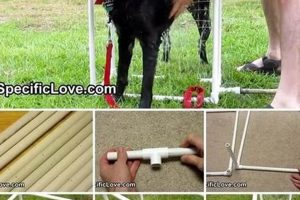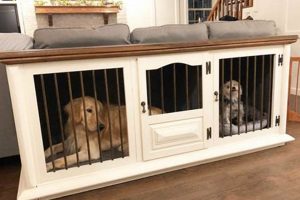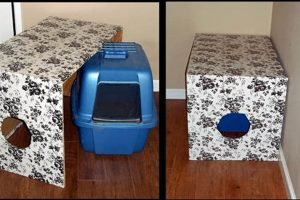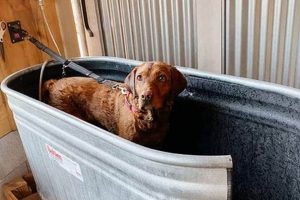A homemade canine carrier offers a practical solution for transporting small or injured dogs. Constructed from readily available materials, these carriers provide support and security, allowing owners to keep their pets close. For example, a simple design might involve repurposing a sturdy fabric bag with reinforced straps, customized to the dog’s size and weight.
The creation of these carrying devices can offer several advantages. It provides a cost-effective alternative to commercially manufactured options, particularly beneficial for owners with limited budgets. Furthermore, constructing a personalized carrier allows for customized fit and support, addressing the specific needs of the animal. Historically, similar homemade solutions have been employed by pet owners seeking accessible and affordable means of transporting their companions.
The following sections will delve into the design considerations, material selection, and construction techniques involved in producing a suitable and safe carrier, providing detailed guidance for pet owners interested in undertaking this project.
Essential Guidance for Crafting a Homemade Canine Carrier
The creation of a safe and effective homemade canine carrier requires careful planning and execution. The following tips provide guidance to ensure the resulting product meets the needs of both dog and owner.
Tip 1: Fabric Selection. Choose a durable, washable fabric capable of supporting the dog’s weight. Heavy-duty cotton canvas or upholstery fabric are suitable options. Avoid slippery materials that could cause the dog to slide.
Tip 2: Secure Straps. Straps should be wide and securely attached to the body of the carrier. Reinforce stitching at stress points to prevent tearing. Adjustable straps allow for customized fit and weight distribution.
Tip 3: Size Appropriateness. Measure the dog accurately and allow sufficient room for comfortable movement. The carrier should not be so large that the dog can easily escape, nor so small that it restricts breathing or movement.
Tip 4: Safety Features. Consider incorporating a safety tether that attaches to the dog’s harness. This prevents the dog from jumping or falling out of the carrier. Avoid using buckles or fasteners that could pinch or irritate the dog.
Tip 5: Weight Distribution. Design the carrier to distribute the dog’s weight evenly across the wearer’s body. This minimizes strain and discomfort during extended use. Consider padding the straps for added comfort.
Tip 6: Reinforcement. Reinforce all seams and stress points with multiple rows of stitching. Consider adding a rigid bottom panel for added support, particularly for larger dogs.
Tip 7: Gradual Introduction. Allow the dog to become accustomed to the carrier before using it in public. Introduce the carrier gradually, rewarding the dog for entering and remaining calm inside.
Adherence to these guidelines can contribute to the creation of a functional and safe homemade canine carrier, offering a comfortable and secure means of transporting a pet.
The subsequent section will address potential safety concerns and maintenance recommendations for prolonged use of the homemade carrier.
1. Fabric durability
Fabric durability is paramount in the construction of a homemade canine carrier. The selection of robust materials directly influences the carrier’s lifespan and its ability to safely support the dog’s weight. Inadequate fabric strength can result in tearing or seam failure, potentially leading to injury to the animal. For example, using lightweight cotton for a large dog carrier is ill-advised, as it lacks the necessary tensile strength to withstand prolonged use and stress.
Conversely, employing heavy-duty materials, such as canvas or reinforced nylon, provides enhanced security and longevity. These fabrics resist tearing and stretching, ensuring the carrier maintains its structural integrity over time. Furthermore, durable fabrics are better equipped to withstand repeated washing and cleaning, essential for maintaining hygiene. Consider the example of a carrier made from repurposed denim; its inherent strength allows it to endure daily use and washing without significant degradation.
Therefore, meticulous consideration of fabric durability is essential when undertaking such a project. Compromising on material quality presents a risk to the dog’s safety and reduces the carrier’s usability. The selection of a suitable, robust fabric ensures the homemade carrier offers a secure and dependable means of transporting a pet. Further research into fabric types and their respective load-bearing capacities is recommended prior to commencing construction.
2. Strap security
Strap security is a critical consideration in the design and construction of a homemade canine carrier, influencing both the safety and comfort of the carried animal, as well as the user. The integrity of the straps directly affects the stability of the carrier and the distribution of weight, impacting the overall usability and safety profile of the device.
- Attachment Integrity
The manner in which straps are affixed to the carrier’s body dictates its load-bearing capacity. Insufficient stitching or weak attachment points can lead to strap detachment under the dog’s weight, causing potential injury. For example, a strap secured with only a single line of stitching is more susceptible to failure than one reinforced with multiple rows and a box-stitch pattern.
- Material Strength and Durability
Strap material significantly impacts the carrier’s longevity and reliability. Low-quality webbing or fabric straps can fray, stretch, or tear under stress, compromising their ability to securely support the dog. Durable materials like nylon webbing or heavy-duty canvas provide superior strength and resistance to wear and tear.
- Adjustability and Fit
Adjustable straps allow for a customized fit, distributing the dog’s weight evenly across the wearer’s shoulders and back. This minimizes strain and discomfort during extended use. However, adjustable buckles or sliders must be robust and securely fastened to prevent slippage or accidental detachment.
- Placement and Ergonomics
The positioning of the straps relative to the carrier’s center of gravity influences the overall balance and stability of the system. Poorly positioned straps can cause the carrier to tilt or sway, making it difficult to maintain control. Ergonomic design considerations, such as padded straps and chest or waist straps, can further enhance comfort and stability.
The preceding elements of strap security are not merely design considerations, but rather essential safety parameters in a homemade canine carrier. Addressing these aspects directly contributes to the creation of a functional and dependable device, ensuring the well-being of the dog and the comfort of the owner. The overall design benefits from reinforced strap attachment, strong materials, adjustable options, and ergonomic placement to guarantee the carrier’s effectiveness and longevity.
3. Size appropriateness
Size appropriateness constitutes a critical factor in the successful creation and utilization of a homemade canine carrier. The correlation between the dog’s dimensions and the carrier’s internal volume directly impacts the animal’s comfort, safety, and the overall functionality of the carrying device. An inadequately sized carrier can lead to a multitude of adverse effects, ranging from mild discomfort to severe physical distress. For instance, a carrier that is too small restricts movement, inhibits proper breathing, and may cause anxiety in the dog. Conversely, an excessively large carrier lacks the necessary support, potentially leading to instability and increasing the risk of injury from uncontrolled movement during transport. The concept of “one size fits all” is demonstrably inapplicable in this context.
Consider the example of a small breed dog, such as a Chihuahua, placed in a carrier designed for a medium-sized breed. The Chihuahua would likely experience a lack of security due to the excessive space, making movement unstable and potentially leading to fear or disorientation. The animal might also struggle to maintain a comfortable posture, leading to muscle strain or fatigue. Similarly, a larger breed, such as a Beagle, forced into a carrier designed for a smaller dog, would face restricted breathing, joint compression, and an overall reduction in comfort, potentially causing long-term musculoskeletal problems. Thus, accurately measuring the dog’s length, height, and weight prior to constructing the carrier is indispensable.
In summary, the importance of size appropriateness in relation to homemade canine carriers cannot be overstated. The dimensions of the carrier should precisely correspond to the physical characteristics of the dog to ensure optimal comfort, safety, and stability during transport. A properly sized carrier minimizes the risk of injury, reduces anxiety, and allows the dog to maintain a natural and comfortable posture. Challenges in achieving precise sizing can be addressed through careful measurement, pattern adjustments, and prototype testing. This connection is essential for a comfortable journey.
4. Safety tether
The inclusion of a safety tether represents a critical safety measure in the design and construction of a homemade canine carrier. This element serves to mitigate the risk of a dog unexpectedly exiting the carrier during transport, potentially preventing injury or escape.
- Prevention of Accidental Escape
The primary function of a safety tether is to restrain the dog within the confines of the carrier. By attaching securely to the dog’s harness or collar, the tether prevents the animal from jumping or falling out, particularly in situations involving sudden movements or unexpected external stimuli. An example of its necessity might be a sudden loud noise startling the dog, prompting an attempt to flee the carrier.
- Secure Attachment Points
The tether itself must be constructed from a durable material capable of withstanding significant force. Furthermore, the attachment points on both the carrier and the dog’s harness or collar must be robust and reliable. Weak or poorly secured attachment points could fail under stress, rendering the tether ineffective. D-rings or swivel clips constructed from metal are often preferred over plastic alternatives due to their increased strength and durability.
- Length and Adjustability Considerations
The length of the safety tether requires careful consideration. It should be short enough to prevent the dog from reaching the edge of the carrier and potentially jumping out, but long enough to allow for comfortable movement and repositioning within the carrier. Adjustable tethers offer increased versatility, accommodating dogs of varying sizes and allowing for adjustments based on the specific circumstances of transport.
- Compatibility with Harness or Collar
The safety tether’s design should ensure compatibility with a range of harnesses and collars. Attaching the tether to a harness is generally preferable to attaching it to a collar, as a harness distributes the force more evenly across the dog’s body, reducing the risk of neck injury. Regardless of the chosen attachment method, it is imperative to verify that the harness or collar fits securely and comfortably, preventing slippage or chafing.
The integration of a well-designed and properly implemented safety tether significantly enhances the safety and security of a homemade canine carrier. By minimizing the risk of accidental escape, the tether contributes to the overall well-being of the dog during transport. In the absence of a robust tether system, the potential for injury or loss increases considerably, underscoring its importance in the creation of a safe and reliable “diy dog sling”.
5. Weight distribution
Weight distribution plays a pivotal role in the functionality and safety of a homemade canine carrier. Ineffective distribution can lead to discomfort for both the dog and the carrier, impacting the practicality and usability of the item. An uneven load can cause strain on the wearer’s back, shoulders, or neck, particularly during extended use. For the dog, poor weight distribution can result in an unstable and uncomfortable ride, potentially leading to anxiety or physical discomfort. For example, a carrier designed with straps that place the majority of the dog’s weight on the wearer’s lower back will likely cause fatigue and pain, rendering it unsuitable for prolonged walks or hikes. Conversely, a carrier with well-distributed weight allows for a more comfortable and stable carrying experience for both parties.
Proper weight distribution is achieved through several design considerations. The placement of the straps is of paramount importance; wide, padded straps that distribute weight across the shoulders, rather than concentrating it on the neck, are essential. A supportive base for the dog to sit or lie upon helps to distribute the animal’s weight evenly across the carrier. The carrier’s shape also influences weight distribution; a design that keeps the dog close to the wearer’s center of gravity reduces strain and improves balance. For example, a wrap-style carrier, which conforms to the wearer’s body and keeps the dog close, typically provides better weight distribution than a bag-style carrier that hangs loosely from the shoulder. Additionally, features such as chest or waist straps can further enhance weight distribution by transferring some of the load from the shoulders to the torso.
In conclusion, understanding and addressing weight distribution is not merely a matter of comfort, but a critical aspect of designing a safe and functional homemade canine carrier. Proper distribution minimizes strain on the wearer, ensures a comfortable and stable ride for the dog, and ultimately contributes to the overall success of the “diy dog sling”. The selection of appropriate strap materials, careful consideration of the carrier’s shape, and the inclusion of supportive features are all essential elements in achieving optimal weight distribution. A carrier designed with these factors in mind will provide a more comfortable and enjoyable experience for both the dog and the owner, promoting its consistent and safe usage.
6. Reinforcement stitching
Reinforcement stitching is an indispensable element in the construction of a “diy dog sling,” directly influencing its durability, safety, and overall effectiveness. It strengthens the seams and stress points of the carrier, mitigating the risk of tearing or failure under the dog’s weight. Without adequate reinforcement, the sling is susceptible to structural weakness, potentially resulting in injury to the animal or rendering the carrier unusable. For example, stress points along the strap attachments or around openings require robust stitching to withstand the dynamic forces exerted during movement. The absence of such reinforcement transforms the carrier into a potential safety hazard.
The application of reinforcement stitching extends beyond simply adding more thread. It involves specific techniques, such as backstitching at the beginning and end of seams, using multiple rows of stitching, and employing specialized stitch patterns like a box stitch or a zigzag stitch to distribute stress more evenly. The choice of thread also plays a crucial role; heavy-duty thread designed for upholstery or canvas is better suited for withstanding the strain placed on the carrier. Real-world examples illustrate this point: a carrier constructed with only basic, single-line stitching may quickly unravel under the weight of even a small dog, whereas a carrier with reinforced seams and stress points demonstrates significantly greater longevity and resistance to wear and tear.
In summary, reinforcement stitching is not merely a decorative addition to a “diy dog sling,” but rather a critical component that ensures its structural integrity and safety. The practical significance of this understanding lies in the increased durability and reliability of the carrier, providing pet owners with a secure and dependable means of transporting their animals. Challenges in achieving adequate reinforcement can be overcome through careful material selection, the application of appropriate stitching techniques, and a commitment to thorough and meticulous craftsmanship. The long-term benefits of this investment in quality construction are evident in the carrier’s extended lifespan and enhanced safety profile.
Frequently Asked Questions Regarding DIY Dog Slings
This section addresses common inquiries and concerns pertaining to the creation and utilization of homemade canine carriers, offering clarity and practical guidance.
Question 1: What constitutes the most suitable fabric for a DIY dog sling?
Durable and washable materials, such as heavy-duty cotton canvas or upholstery fabric, are recommended. These fabrics offer the necessary strength to support the dog’s weight while facilitating easy cleaning.
Question 2: How should one ensure the straps of a DIY dog sling are adequately secure?
Wide straps, securely attached to the carrier body with reinforced stitching at stress points, are essential. Adjustable straps allow for customized fit and optimal weight distribution.
Question 3: How does one determine the appropriate size for a DIY dog sling?
Accurate measurements of the dog’s length, height, and weight are crucial. The carrier should provide sufficient room for comfortable movement without allowing the dog to easily escape.
Question 4: Is a safety tether a necessary component of a DIY dog sling?
A safety tether is highly recommended. It attaches to the dog’s harness and prevents the animal from jumping or falling out of the carrier during transport.
Question 5: How can one effectively distribute the dog’s weight when using a DIY dog sling?
The design should distribute the dog’s weight evenly across the wearer’s body, minimizing strain and discomfort. Wide, padded straps and strategically positioned support structures contribute to effective weight distribution.
Question 6: What reinforcement techniques are advisable when constructing a DIY dog sling?
Multiple rows of stitching at seams and stress points are essential. Employing a box stitch or zigzag stitch pattern further enhances the structural integrity of the carrier.
In summary, the creation of a safe and functional “diy dog sling” hinges on careful material selection, secure construction techniques, and a thorough understanding of the dog’s individual needs.
The subsequent section will explore potential design variations and customization options for homemade canine carriers.
DIY Dog Sling
The preceding sections have explored critical elements in the design and construction of a diy dog sling. Emphasis has been placed on material selection, structural integrity, safety features, and ergonomic considerations. Understanding these aspects is paramount to creating a functional and safe carrier for small canines.
The construction of a diy dog sling represents a commitment to both practicality and pet welfare. While commercial options exist, the customized approach afforded by a do-it-yourself project allows for tailored solutions that address the unique needs of individual animals. Owners are encouraged to prioritize safety and comfort in every stage of the design and construction process, ensuring a positive experience for both pet and owner. Continued vigilance regarding wear and tear, coupled with adherence to the principles outlined herein, will contribute to the long-term utility and safety of the diy dog sling.







